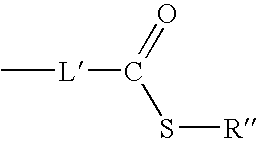Site-specific labelling of proteins using acridone and quinacridone lifetime dyes
a lifetime reporter and protein technology, applied in the field of site-specific labeling of proteins with acridone and quinacridone dyes, can solve the problem of no reports describing thioester derivatives of fluorescent lifetime reporter molecules
- Summary
- Abstract
- Description
- Claims
- Application Information
AI Technical Summary
Problems solved by technology
Method used
Image
Examples
second embodiment
[0038] In a second embodiment according to the first aspect, the compound is a quinacridone dye having the formula (III): 6
[0039] wherein:
[0040] groups R.sup.13 and R.sup.14 are attached to the Z.sup.1 ring structure and groups R.sup.15 and R.sup.16 are attached to the Z.sup.2 ring structure;
[0041] Z.sup.1 and Z.sup.2 independently represent the atoms necessary to complete one ring or two fused ring aromatic or heteroaromatic systems, each ring having five or six atoms selected from carbon atoms and optionally no more than two atoms selected from oxygen, nitrogen and sulphur; at least one of groups R.sup.11, R.sup.12, R.sup.13, R.sup.14, R.sup.15, R.sup.16, R.sup.17 and R.sup.18 is the group F where F is a target bonding group selected from a thioester group and a 1,2-aminothiol group; and
[0042] when any of said groups R.sup.13, R.sup.14, R.sup.15, R.sup.16, R.sup.17 and R.sup.18 is not said group F, said remaining groups R.sup.13, R.sup.14, R.sup.15, R.sup.16, R.sup.17 and R.sup.18...
examples
[0077] 1. 9-Oxo-10-{6-oxo-6-[2-sulfoethyl)thio]hexyl}-9,10-dihydroacridine--2-sulphonic acid (Ace-MESNA) 8
[0078] To a stirred solution of 9-oxo-10-{6-carboxyhexyl}-9,10-dihydroacri-dine-2-sulphonic acid (38.9 mg, 0.1 mmol) and 2-mercaptoethylsulphonic acid, sodium salt (MESNA) (25.2 mg, 0.153 mmol) in anhydrous dimethylformamide (3 ml) at ambient temperature was added a solution of dimethylaminopyridine (13.4 mg, 0.11 mmol) in anhydrous dimethylformamide (1.25 ml) followed by a solution of 1-hyroxybenzotriazole (17.9 mg, 0.132 mmol) in anhydrous dimethylformamide (0.5 ml). To this mixture was added as a solid, dried 4A molecular sieves(.about.1 g, <5 micron, activated, powder). The mixture was allowed to stir under a dry nitrogen atmosphere for 30 minutes, and this was followed by addition of N,N'-diisopropylcarbodiimide (126 mg, 155 ul, 1 mmol). The mixture was stirred under a dry nitrogen atmosphere for 15 hours. Thin layer chromatography analysis (reverse phase C18 plates, eluent...
PUM
| Property | Measurement | Unit |
|---|---|---|
| Fluorescence | aaaaa | aaaaa |
| Affinity | aaaaa | aaaaa |
Abstract
Description
Claims
Application Information
 Login to View More
Login to View More - R&D
- Intellectual Property
- Life Sciences
- Materials
- Tech Scout
- Unparalleled Data Quality
- Higher Quality Content
- 60% Fewer Hallucinations
Browse by: Latest US Patents, China's latest patents, Technical Efficacy Thesaurus, Application Domain, Technology Topic, Popular Technical Reports.
© 2025 PatSnap. All rights reserved.Legal|Privacy policy|Modern Slavery Act Transparency Statement|Sitemap|About US| Contact US: help@patsnap.com



